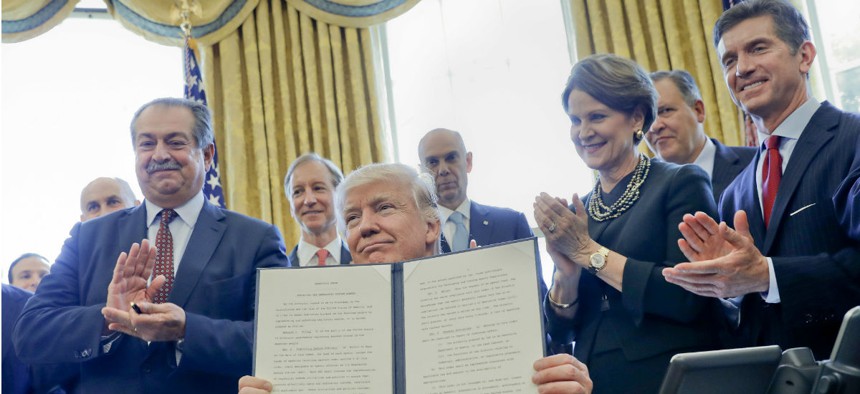
Trump holds up his executive order creating regulatory reform task forces. Pablo Martinez Monsivais/AP
White House Lays Out Plan to Hold Agencies Accountable for Cutting Regulations
Efforts will be roped into existing agency performance plans.
The White House plans to hold agencies to strict account as they begin efforts to reduce their regulatory operations, requiring them to create goals and report regularly on their progress.
In recent guidance spelling out how to comply with President Trump’s executive order establishing task forces across government to weed out unnecessary regulations, the Office of Management and Budget directed agencies to develop performance metrics in conjunction with their 2010 Government Performance and Results Modernization Act efforts. Dominic Mancini, acting administrator for OMB’s Office of Information and Regulatory Affairs, said the reporting requirements of the February order would apply to all Cabinet-level departments, as well as the Environmental Protection Agency and NASA. Independent regulatory agencies are not subject to the order, Mancini said, though they are “still encouraged to comply.”
As part of their fiscal 2019 agency performance plans, agencies will have to list an array of data on their regulatory reaches and related goals. The information will include the number of evaluations the agencies held to identify deregulatory actions, the number of deregulatory actions recommended by their task forces and the actions taken to address those suggestions. They will also report on the total regulatory and deregulatory actions they issue, as defined by the order, as well as their costs.
Agency goals should include both numerical targets as well as the timeframe in which they hope to meet them. As they review their fiscal 2019 plans, agencies should also set goals for fiscal 2018, Mancini said.
Agencies will establish and report on other performance goals, such as the costs and benefits of their entire regulatory programs and how to improve the net benefits. They will also track their progress in terminating various programs and activities for which the administration has rescinded the authority.
OMB will grant waivers from the requirements of the order to any agency that proves it “generally issues very few or no regulations.”
“Every regulation should have to pass a simple test,” Trump said in February when he signed the order. “Does it make life better or safer for American workers or consumers. If the answer is ‘no,’ we will be getting rid of it and getting rid of it quickly.”
Federal regulatory experts, however, have warned eliminating such regulations could be easier said than done. Both the George W. Bush and Obama administrations have already completed retrospective reviews that attempted to eliminate or streamline high-impact, unnecessarily burdensome regulations. The “low-hanging fruit,” according to Amit Narang, a regulatory policy expert for Public Citizen, has already been picked.
Narang was critical of the executive order when Trump signed it, saying it would allow Trump to install “hand-picked deregulatory henchmen in agencies throughout our government and empower them to hack away at critical public protections.”
Sen. James Lankford, R-Okla., who chairs the Senate Homeland Security and Governmental Affairs Subcommittee on Regulatory Affairs and Federal Management, applauded the approach, however, saying it “adds some teeth to retrospective review by putting processes in place and holding agencies accountable."
In addition to the task force order, Trump signed a separate EO requiring agencies to cut or streamline two regulations for every new one they issue.







